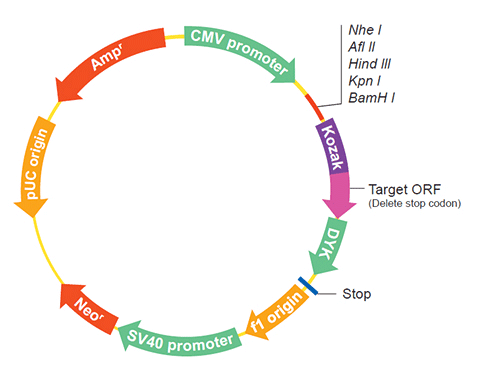| Gene Symbol | TMEM257 |
| Entrez Gene ID | 9142 |
HOME
ORF » Species Summary » TMEM257 cDNA ORF clone
| Gene Symbol | TMEM257 |
| Entrez Gene ID | 9142 |


The following TMEM257 gene cDNA ORF clone sequences were retrieved from the NCBI Reference Sequence Database (RefSeq). These sequences represent the protein coding region of the TMEM257 cDNA ORF which is encoded by the open reading frame (ORF) sequence. ORF sequences can be delivered in our standard vector, pcDNA3.1+/C-(K)DYK or the vector of your choice as an expression/transfection-ready ORF clone. Not the clone you want? Click here to find your clone.
| CloneID | OHu19187 |
|
| Clone ID Related Accession (Same CDS sequence) | NM_004709.2 | |
| Accession Version | NM_004709.2 Latest version! | Documents for ORF clone product in default vector |
| Sequence Information | ORF Nucleotide Sequence (Length: 336bp) Protein sequence SNP |
|
| Vector | pcDNA3.1-C-(k)DYK or customized vector |  User Manual User Manual |
| Clone information | Clone Map |  MSDS MSDS |
| Tag on pcDNA3.1+/C-(K)DYK | C terminal DYKDDDDK tags | |
| ORF Insert Method | CloneEZ™ Seamless cloning technology | |
| Insert Structure | linear | |
| Update Date | 2016-09-14 | |
| Organism | Homo sapiens(Human) | |
| Product | transmembrane protein 257 | |
| Comment | VALIDATED REFSEQ: This record has undergone validation or preliminary review. The reference sequence was derived from Y08902.1, AL134413.1 and AF007148.1. This sequence is a reference standard in the RefSeqGene project. On Apr 2, 2004 this sequence version replaced NM_004709.1. ##Evidence-Data-START## Transcript is intronless :: Y08902.1 [ECO:0000345] ##Evidence-Data-END## COMPLETENESS: complete on the 3' end. | |
1 | ATGTATTCCA GACTATTTTA TTTAAAATCA TCATACATCA TATACTTTGA ACCTTTATTT |
The stop codons will be deleted if pcDNA3.1+/C-(K)DYK vector is selected.
| RefSeq | NP_004700.1 |
| CDS | 269..604 |
| Translation |

Target ORF information:
Target ORF information:
|
 NM_004709.2 NM_004709.2 |

1 | ATGTATTCCA GACTATTTTA TTTAAAATCA TCATACATCA TATACTTTGA ACCTTTATTT |
The stop codons will be deleted if pcDNA3.1+/C-(K)DYK vector is selected.
The DNA sequence of the human X chromosome. |
Identification of CXorf1, a novel intronless gene in Xq27.3, expressed in human hippocampus. |